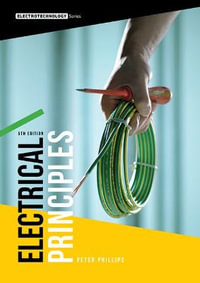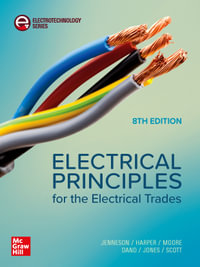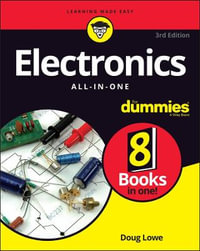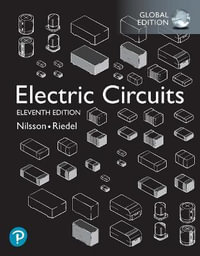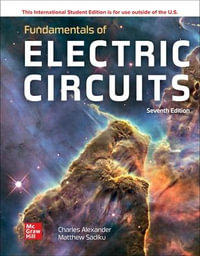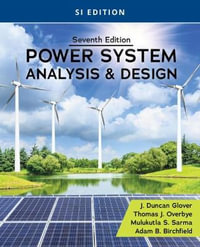
High Speed Signal Propagation
Advanced Black Magic
By: Howard Johnson
Hardcover | 24 February 2003 | Edition Number 1
At a Glance
808 Pages
24.13 x 18.42 x 3.81
Hardcover
$346.25
or 4 interest-free payments of $86.56 with
orAims to ship in 10 to 15 business days
When will this arrive by?
Enter delivery postcode to estimate
| Preface | p. xxi |
| Glossary of Symbols | p. xxvii |
| Fundamentals | p. 1 |
| Impedance of Linear, Time-Invariant, Lumped-Element Circuits | p. 1 |
| Power Ratios | p. 2 |
| Rules of Scaling | p. 5 |
| Scaling of Physical Size | p. 6 |
| Power Scaling | p. 9 |
| Time Scaling | p. 10 |
| Impedance Scaling with Constant Voltage | p. 12 |
| Dielectric-Constant Scaling | p. 14 |
| Magnetic Permeability Scaling | p. 15 |
| The Concept of Resonance | p. 16 |
| Extra for Experts: Maximal Linear System Response to a Digital Input | p. 22 |
| Transmission Line Parameters | p. 29 |
| Telegrapher's Equations | p. 31 |
| So Good It Works on Barbed Wire | p. 34 |
| The No-Storage Principle and Its Implications for Returning Signal Current | p. 35 |
| Derivation of Telegrapher's Equations | p. 38 |
| Definition of Characteristic Impedance ZC | p. 39 |
| Changes in Characteristic Impedance | p. 40 |
| Calculation of Impedance Zc From Parameters R, L, G, And C | p. 41 |
| Definition of Propagation Coefficient [gamma] | p. 44 |
| Calculation of Propagation Coefficient [gamma] from Parameters R, L, G, and C | p. 46 |
| Ideal Transmission Line | p. 48 |
| DC Resistance | p. 55 |
| DC Conductance | p. 57 |
| Skin Effect | p. 58 |
| What Causes the Skin Effect, and What Does It Have to Do With Skin? | p. 58 |
| Eddy Currents within a Conductor | p. 61 |
| High and Low-Frequency Approximations for Series Resistance | p. 63 |
| Skin-Effect Inductance | p. 66 |
| Modeling Internal Impedance | p. 67 |
| Practical Modeling of Internal Impedance | p. 70 |
| Special Issues Concerning Rectangular Conductors | p. 73 |
| Concentric-Ring Skin-Effect Model | p. 75 |
| Modeling Skin Effect | p. 76 |
| Regarding Modeling Skin Effect | p. 79 |
| Proximity Effect | p. 79 |
| Proximity Factor | p. 81 |
| Proximity Effect for Coaxial Cables | p. 84 |
| Proximity Effect for Microstrip and Stripline Circuits | p. 85 |
| Last Words on Proximity Effect | p. 85 |
| Surface Roughness | p. 90 |
| Severity of Surface Roughness | p. 90 |
| Onset of Roughness Effect | p. 91 |
| Roughness of PCB Materials | p. 91 |
| Controlling Roughness | p. 92 |
| Dielectric Effects | p. 94 |
| Dielectric Loss Tangent | p. 98 |
| Rule of Mixtures | p. 99 |
| Calculating the Loss Tangent for a Uniform Dielectric Mixture | p. 101 |
| Calculating the Loss Tangent When You Don't Know q | p. 103 |
| Causality and the Network Function Relations | p. 105 |
| Finding [vertical bar]er[vertical bar] to Match a Measured Loss Tangent | p. 110 |
| Kramers-Kronig Relations | p. 114 |
| Complex Magnetic Permeability | p. 115 |
| Impedance in Series with the Return Path | p. 115 |
| Slow-Wave Mode On-Chip | p. 117 |
| Performance Regions | p. 121 |
| Signal Propagation Model | p. 121 |
| Extracting Parameters for RLGC Simulators | p. 127 |
| Hierarchy of Regions | p. 128 |
| A Transmission Line Is Always a Transmission Line | p. 130 |
| Necessary Mathematics: Input Impedance and Transfer Function | p. 132 |
| Lumped-Element Region | p. 135 |
| Boundary of Lumped-Element Region | p. 136 |
| Pi Model | p. 137 |
| Taylor-Series Approximation of H (Lumped-Element Region) | p. 139 |
| Input impedance (Lumped-Element Region) | p. 140 |
| Transfer Function (Lumped-Element Region) | p. 143 |
| Step Response (Lumped-Element Region) | p. 145 |
| RC Region | p. 148 |
| Boundary of RC Region | p. 149 |
| Input Impedance (RC Region) | p. 151 |
| Characteristic Impedance (RC Region) | p. 152 |
| General Behavior within RC Region | p. 153 |
| Propagation Coefficient (RC Region) | p. 155 |
| Transfer Function (RC Region) | p. 155 |
| Normalized Step Response (RC Region) | p. 157 |
| Tradeoffs Between Distance and Speed (RC Region) | p. 159 |
| Closed-Form Solution for Step Response (RC Region) | p. 159 |
| Elmore Delay Estimation (RC Region) | p. 160 |
| LC Region (Constant-Loss Region) | p. 166 |
| Boundary of LC Region | p. 166 |
| Characteristic Impedance (LC Region) | p. 167 |
| Influence of Series Resistance on TDR Measurements | p. 169 |
| Propagation Coefficient (LC Region) | p. 173 |
| Possibility of Severe Resonance within the LC Region | p. 176 |
| Terminating an LC Transmission Line | p. 179 |
| Tradeoffs Between Distance And Speed (LC Region) | p. 183 |
| Mixed-Mode Operation (LC and RC Regions) | p. 184 |
| Skin-Effect Region | p. 185 |
| Boundary of Skin-Effect Region | p. 185 |
| Characteristic Impedance (Skin-Effect Region) | p. 186 |
| Influence of Skin-Effect on TDR Measurement | p. 188 |
| Propagation Coefficient (Skin-Effect Region) | p. 189 |
| Possibility of Severe Resonance within Skin-Effect Region | p. 193 |
| Step Response (Skin-Effect Region) | p. 195 |
| Tradeoffs Between Distance and Speed (Skin-Effect Region) | p. 199 |
| Dielectric Loss Region | p. 200 |
| Boundary of Dielectric-Loss-Limited Region | p. 200 |
| Characteristic Impedance (Dielectric-Loss-Limited Region) | p. 202 |
| Influence of Dielectric Loss on TDR Measurement | p. 205 |
| Propagation Coefficient (Dielectric-Loss-Limited Region) | p. 206 |
| Possibility of Severe Resonance within Dielectric-Loss Limited Region | p. 210 |
| Step Response (Dielectric-Loss-Limited Region) | p. 212 |
| Tradeoffs Between Distance and Speed (Dielectric-Loss Region) | p. 216 |
| Waveguide Dispersion Region | p. 216 |
| Boundary of Waveguide-Dispersion Region | p. 217 |
| Summary of Breakpoints Between Regions | p. 218 |
| Equivalence Principle for Transmission Media | p. 221 |
| Scaling Copper Transmission Media | p. 224 |
| Scaling Multimode Fiber-Optic Cables | p. 229 |
| Linear Equalization: Long Backplane Trace Example | p. 230 |
| Adaptive Equalization: Accelerant Networks Transceiver | p. 234 |
| Frequency-Domain Modeling | p. 237 |
| Going Nonlinear | p. 237 |
| Approximations to the Fourier Transform | p. 239 |
| Discrete Time Mapping | p. 241 |
| Other Limitations of the FFT | p. 243 |
| Normalizing the Output of an FFT Routine | p. 243 |
| Deriving the DFT Normalization Factors | p. 244 |
| Useful Fourier Transform-Pairs | p. 245 |
| Effect of Inadequate Sampling Rate | p. 247 |
| Implementation of Frequency-Domain Simulation | p. 249 |
| Embellishments | p. 251 |
| What if a Large Bulk-Transport Delay Causes the Waveform to Slide Off the end of the Time-Domain Window? | p. 251 |
| How Do I Transform an Arbitrary Data Sequence? | p. 251 |
| How Do I Shift the Time-Domain Waveforms? | p. 252 |
| What If I Want to Model a More Complicated System? | p. 252 |
| What About Differential Modeling? | p. 252 |
| Checking the Output of Your FFT Routine | p. 253 |
| Pcb (printed-circuit board) Traces | p. 255 |
| Pcb Signal Propagation | p. 257 |
| Characteristic Impedance and Delay | p. 257 |
| Resistive Effects | p. 258 |
| Dielectric Effects | p. 268 |
| Mixtures of Skin Effect and Dielectric Loss | p. 281 |
| Non-TEM Modes | p. 282 |
| Limits to Attainable Distance | p. 288 |
| SONET Data Coding | p. 291 |
| Pcb Noise and Interference | p. 294 |
| Pcb: Reflections | p. 294 |
| Pcb Crosstalk | p. 318 |
| Pcb Connectors | p. 326 |
| Mutual Understanding | p. 326 |
| Through-Hole Clearances | p. 328 |
| Measuring Connectors | p. 330 |
| Tapered Transitions | p. 332 |
| Straddle-Mount Connectors | p. 335 |
| Cable Shield Grounding | p. 336 |
| Modeling Vias | p. 338 |
| Incremental Parameters of a Via | p. 338 |
| Three Models for a Via | p. 341 |
| Dangling Vias | p. 343 |
| Capacitance Data | p. 345 |
| Inductance Data | p. 351 |
| The Future of On-Chip Interconnections | p. 359 |
| Differential Signaling | p. 363 |
| Single-Ended Circuits | p. 363 |
| Two-Wire Circuits | p. 368 |
| Differential Signaling | p. 370 |
| Differential and Common-Mode Voltages and Currents | p. 374 |
| Differential and Common-Mode velocity | p. 376 |
| Common-Mode Balance | p. 377 |
| Common-Mode Range | p. 378 |
| Differential to Common-Mode Conversion | p. 378 |
| Differential Impedance | p. 380 |
| Relation Between Odd-Mode and Uncoupled Impedance | p. 383 |
| Why the Odd-Mode Impedance Is Always Less Than the Uncoupled Impedance | p. 383 |
| Differential Reflections | p. 384 |
| Pcb Configurations | p. 385 |
| Differential (Microstrip) Trace Impedance | p. 386 |
| Edge-Coupled Stripline | p. 389 |
| Breaking Up a Pair | p. 397 |
| Broadside-Coupled Stripline | p. 399 |
| PCB Applications | p. 404 |
| Matching to an External, Balanced Differential Transmission Medium | p. 404 |
| Defeating ground bounce | p. 405 |
| Reducing EMI with Differential Signaling | p. 405 |
| Punching Through a Noisy Connector | p. 407 |
| Reducing Clock Skew | p. 409 |
| Reducing Local Crosstalk | p. 411 |
| A Good Reference about Transmission Lines | p. 413 |
| Differential Clocks | p. 413 |
| Differential Termination | p. 414 |
| Differential U-Turn | p. 417 |
| Your Layout Is Skewed | p. 419 |
| Buying Time | p. 420 |
| Intercabinet Applications | p. 422 |
| Ribbon-Style Twisted-Pair Cables | p. 423 |
| Immunity to Large Ground Shifts | p. 424 |
| Rejection of External Radio-Frequency Interference (RFI) | p. 426 |
| Differential Receivers Have Superior Tolerance to Skin Effect and Other High-Frequency Losses | p. 427 |
| LVDS Signaling | p. 429 |
| Output Levels | p. 429 |
| Common-Mode Output | p. 430 |
| Common-Mode Noise Tolerance | p. 430 |
| Differential-Mode Noise Tolerance | p. 431 |
| Hysteresis | p. 431 |
| Impedance Control | p. 432 |
| Trace Radiation | p. 435 |
| Risetime | p. 435 |
| Input Capacitance | p. 435 |
| Skew | p. 435 |
| Fail-Safe | p. 436 |
| Generic Building-Cabling Standards | p. 439 |
| Generic Cabling Architecture | p. 442 |
| SNR Budgeting | p. 446 |
| Glossary of Cabling Terms | p. 446 |
| Preferred Cable Combinations | p. 449 |
| FAQ: Building-Cabling Practices | p. 449 |
| Crossover Wiring | p. 451 |
| Plenum-Rated Cables | p. 452 |
| Laying cables in an Uncooled Attic Space | p. 453 |
| FAQ: Older Cable Types | p. 453 |
| 100-Ohm Balanced Twisted-Pair Cabling | p. 457 |
| UTP Signal Propagation | p. 459 |
| UTP Modeling | p. 460 |
| Adapting the Metallic-Transmission Model | p. 462 |
| UTP Transmission Example: 10BASE-T | p. 465 |
| UTP Noise and Interference | p. 471 |
| UTP: Far-End Reflections | p. 471 |
| UTP: Near-End Reflections | p. 475 |
| UTP: Hybrid Circuits | p. 481 |
| UTP: Near-End Crosstalk | p. 487 |
| UTP: Alien crosstalk | p. 490 |
| UTP: Far-End Crosstalk | p. 490 |
| Power sum NEXT and ELFEXT | p. 493 |
| UTP: Radio-Frequency Interference | p. 493 |
| UTP: Radiation | p. 496 |
| UTP Connectors | p. 497 |
| Issues with Screening | p. 501 |
| Category-3 UTP at Elevated Temperature | p. 502 |
| 150-Ohm STP-A Cabling | p. 505 |
| 150-[Omega] STP-A Signal Propagation | p. 506 |
| 150-[Omega] STP-A Noise and Interference | p. 506 |
| 150-[Omega] STP-A: Skew | p. 507 |
| 150-[Omega] STP-A: Radiation and Safety | p. 508 |
| 150-[Omega] STP-A: Comparison with UTP | p. 509 |
| 150-[Omega] STP-A Connectors | p. 509 |
| Coaxial Cabling | p. 513 |
| Coaxial Signal Propagation | p. 515 |
| Stranded Center-Conductors | p. 522 |
| Why 50 Ohms? | p. 523 |
| 50-Ohm Mailbag | p. 526 |
| Coaxial Cable Noise and Interference | p. 528 |
| Coax: Far-End Reflected Noise | p. 528 |
| Coax: Radio Frequency Interference | p. 529 |
| Coax: Radiation | p. 529 |
| Coaxial Cable: Safety Issues | p. 530 |
| Coaxial Cable Connectors | p. 532 |
| Fiber-Optic Cabling | p. 537 |
| Making Glass Fiber | p. 538 |
| Finished Core Specifications | p. 539 |
| Cabling the Fiber | p. 541 |
| Wavelengths of Operation | p. 543 |
| Multimode Glass Fiber-Optic Cabling | p. 544 |
| Multimode Signal Propagation | p. 546 |
| Why Is Graded-Index Fiber Better than Step-Index? | p. 551 |
| Standards for Multimode Fiber | p. 552 |
| What Considerations Govern the Use of 50-micron Fiber? | p. 554 |
| Multimode Optical Performance Budget | p. 555 |
| Jitter | p. 568 |
| Multimode Fiber-Optic Noise and Interference | p. 570 |
| Multimode Fiber Safety | p. 571 |
| Multimode Fiber with Laser Source | p. 571 |
| VCSEL Diodes | p. 573 |
| Multimode Fiber-Optic Connectors | p. 575 |
| Single-Mode Fiber-Optic Cabling | p. 576 |
| Single-Mode Signal Propagation | p. 577 |
| Single-Mode Fiber-Optic Noise and Interference | p. 578 |
| Single-Mode Fiber Safety | p. 578 |
| Single-Mode Fiber-Optic Connectors | p. 578 |
| Clock Distribution | p. 579 |
| Extra Fries, Please | p. 582 |
| Arithmetic of Clock Skew | p. 584 |
| Clock Repeaters | p. 589 |
| Active Skew Correction | p. 593 |
| Zero-Delay Clock Repeaters | p. 594 |
| Compensating for Line Length | p. 595 |
| Stripline vs. Microstrip Delay | p. 596 |
| Importance of Terminating Clock Lines | p. 599 |
| Effect of Clock Receiver Thresholds | p. 601 |
| Effect of Split Termination | p. 602 |
| Intentional Delay Adjustments | p. 605 |
| Fixed Delay | p. 605 |
| Adjustable Delays | p. 607 |
| Automatically Programmable Delays | p. 609 |
| Serpentine Delays | p. 610 |
| Switchback Coupling | p. 612 |
| Driving Multiple Loads with Source Termination | p. 616 |
| To Tee or Not To Tee | p. 619 |
| Driving Two Loads | p. 625 |
| Daisy-Chain Clock Distribution | p. 627 |
| Case Study of Daisy-Chained Clock | p. 629 |
| The Jitters | p. 634 |
| When Clock Jitter Matters | p. 636 |
| Measuring Clock Jitter | p. 648 |
| Power Supply Filtering for Clock Sources, Repeaters, and PLL Circuits | p. 656 |
| Healthy Power | p. 659 |
| Clean Power | p. 661 |
| Intentional Clock Modulation | p. 663 |
| Signal Integrity Mailbag | p. 665 |
| Jitter-Free Clocks | p. 667 |
| Reduced-Voltage Signaling | p. 668 |
| Controlling Crosstalk on Clock Lines | p. 669 |
| Reducing Emissions | p. 670 |
| Time-Domain Simulation Tools and Methods | p. 673 |
| Ringing in a New Era | p. 673 |
| Signal Integrity Simulation Process | p. 674 |
| How Much Modeling Do You Need? | p. 676 |
| What Happens After Parameter Extraction? | p. 676 |
| A Word of Caution | p. 677 |
| The Underlying Simulation Engine | p. 678 |
| Evolving Forward | p. 680 |
| Pitfalls of SPICE-Like Algorithms | p. 680 |
| Transmission Lines | p. 682 |
| Interpreting Your Results | p. 684 |
| Using SPICE Intelligently | p. 685 |
| IBIS (I/O Buffer Information Specification) | p. 685 |
| What Is IBIS? | p. 686 |
| Who Created IBIS? | p. 686 |
| What Is Good About IBIS? | p. 687 |
| What's Wrong with IBIS? | p. 687 |
| What You Can Do to Help | p. 688 |
| IBIS: History and Future Direction | p. 689 |
| IBIS Historical Overview | p. 689 |
| Comparison to SPICE | p. 690 |
| Future Directions | p. 690 |
| IBIS: Issues with Interpolation | p. 691 |
| IBIS: Issues with SSO Noise | p. 695 |
| Nature of EMC Work | p. 697 |
| EMC Simulation | p. 698 |
| Power and Ground Resonance | p. 699 |
| Collected References | p. 703 |
| Points to Remember | p. 710 |
| Building a Signal Integrity Department | p. 731 |
| Calculation of Loss Slope | p. 733 |
| Two-Port Analysis | p. 735 |
| Simple Cases Involving Transmission Lines | p. 737 |
| Fully Configured Transmission Line | p. 739 |
| Complicated Configurations | p. 741 |
| Accuracy of Pi Model | p. 743 |
| Pi-Model Operated in the LC Region | p. 745 |
| erf() | p. 747 |
| Index | p. 749 |
| Table of Contents provided by Ingram. All Rights Reserved. |
ISBN: 9780130844088
ISBN-10: 013084408X
Series: Prentice Hall Modern Semiconductor Design
Published: 24th February 2003
Format: Hardcover
Language: English
Number of Pages: 808
Audience: College, Tertiary and University
Publisher: Pearson Education (US)
Country of Publication: US
Edition Number: 1
Dimensions (cm): 24.13 x 18.42 x 3.81
Weight (kg): 1.38
Shipping
| Standard Shipping | Express Shipping | |
|---|---|---|
| Metro postcodes: | $9.99 | $14.95 |
| Regional postcodes: | $9.99 | $14.95 |
| Rural postcodes: | $9.99 | $14.95 |
How to return your order
At Booktopia, we offer hassle-free returns in accordance with our returns policy. If you wish to return an item, please get in touch with Booktopia Customer Care.
Additional postage charges may be applicable.
Defective items
If there is a problem with any of the items received for your order then the Booktopia Customer Care team is ready to assist you.
For more info please visit our Help Centre.
You Can Find This Book In
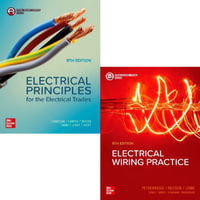
Electrical Wiring Practice, 9th Edition and Wiring Principles for Electrical Trades, 8th Edition (Pack)
Not Supplied By Publisher
$294.95
This product is categorised by
- Non-FictionEngineering & TechnologyElectronics & Communications EngineeringCommunications Engineering & Telecommunications
- Non-FictionComputing & I.T.Computer Networking & Communications
- Non-FictionEngineering & TechnologyElectronics & Communications EngineeringElectronics EngineeringCircuits & Components
- Non-FictionComputing & I.T.Computer ScienceDigital Signal Processing (DSP)
- Non-FictionEngineering & TechnologyEnergy Technology & EngineeringElectrical Engineering
